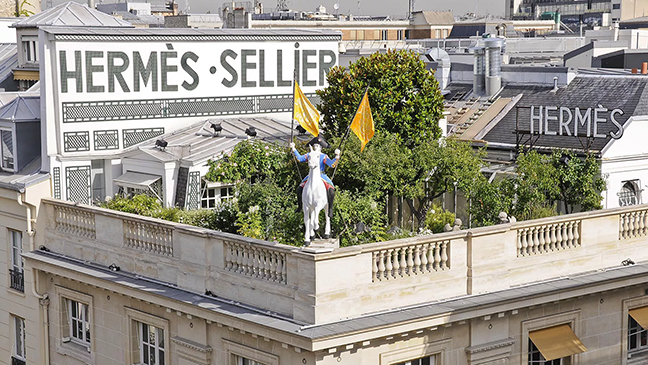Handcrafted luxury designer Hermès has been a family business to watch for generations, just as we noted in our original story in 2015. Unlike some of its competitors, Hermès seems to weather economic storms with ease, making the Hermès family one of the wealthiest in the world, as Bloomberg noted in December. We loved that Bloomberg picked up this story because Hermès has a compelling story to tell.
So, what has the Hermès family done differently? At CMG, we think three things make the family unique and worth watching:
1. THE FAMILY HAS INVESTED SIGNIFICANTLY IN UNIFYING ITS MEMBERS AND RETAINING CONTROL OF THE BUSINESS.
 Bernard Arnault, chief executive of Moët Hennessy Louis Vuitton (LVMH), surprised the Hermès family in 2010 by secretly buying up about 23% of the company’s shares. The family’s response shows just how serious they are about staying unified and retaining control. Fifty family members banded together to form a holding structure, amassing a majority of the company shares. In a remarkable demonstration of family unity, they tied up their wealth in the company for decades to keep control.
Bernard Arnault, chief executive of Moët Hennessy Louis Vuitton (LVMH), surprised the Hermès family in 2010 by secretly buying up about 23% of the company’s shares. The family’s response shows just how serious they are about staying unified and retaining control. Fifty family members banded together to form a holding structure, amassing a majority of the company shares. In a remarkable demonstration of family unity, they tied up their wealth in the company for decades to keep control.
In late 2022, the family carried on this unification process. It brought together eight family offices and investment vehicles to form Krefeld Invest, charged with investing the personal wealth of the heirs. At the end of 2022, the family had also increased its ownership to 67% of Hermès, compared to LVMH’s 2%.
“A big part of being built to last is ensuring that your family members are clear on the purpose, values and future direction of your company,” says Peter Creaghan, Partner at CMG. “To quote from one of our favourite clients, the Hermès family has a special focus on ‘the business of the family.’ When you achieve that level of focus and determination, what flows from that is the unity and togetherness that strengthens the family and the company for the inevitable future shocks they will experience. It’s like having a strong balance sheet, only with the culture of the family. It’s what we mean when we talk about family capital.”
2. HERMÈS DOES NOT COMPETE.
Hermès keeps to what it does well. They don’t measure themselves against their competitors. Designs stay the same for generations. People work at the company for decades. Unusual in the business world, Hermès still conducts its earnings calls in French. The family also doesn’t capitulate to trends or think “quarterly.” It takes the long view. Axel Dumas, executive chairman and a sixth-generation family member, told a business class in 2019 that the company doesn’t “do marketing” or pay celebrities or influencers to carry their bags.
The company plans its production growth at a very conservative 7% a year, opening one factory per year, and no more. The artisans who work in its ateliers go through extensive training to develop the “savoir-faire” needed to craft Hermès’ exquisite products. Only so many of them can be trained per year. But they are consistently true to the traditions that Hermès was built on, including rigorous attention to craftsmanship, detail, and quality. These traditions have garnered fantastic results and made Hermès products investment-worthy. With the family at the helm, it can plan for the long term and invest in the future of the company.
3. HERMÈS IS RESILIENT BECAUSE IT STAYS TRUE TO ITS CORE VALUES.
Hermès bags, purses, scarves and watches are still handmade. Each item is only handled by one craftsperson. It takes 20 hours to make a single Kelly leather bag, one of its most famous designs, named after Grace Kelly in the 1950s. This focus on quality also means that the company can only make so many bags per year, creating exclusivity and scarcity. High demand and long waitlists for the highly coveted bags lead to company results that far exceed their competitors. Those that covet these high-end bags see them as investments and won’t compromise. This loyalty helps Hermès withstand economic downturns.
In this time of restrained consumer spending, aspirational spenders are the first to go. Luxury brands that do well are those that are “serving big-spending customers, not just in terms of the item value but the overall annual spend, versus who is serving that large customer base that is only spending occasionally,” Michael Kliger, chief executive of luxury ecommerce retailer Mytheresa, told the Financial Times late last year.
A majority of OECD economists predict even slower global growth in 2024, due to continuing inflation and geopolitical uncertainty. It remains to be seen if Hermès will continue to buck industry trends. But the Hermès family’s unwavering commitment to its core values seems to be a strategy that is working.

We at CMG see many valuable lessons in the example of the Hermès family. It has crafted a careful, deliberate plan for the business and the future, based on quality, unity, and fierce independence.
“Solidifying family business structures and standing firm in your company’s values gives clarity and stability for the company and the family,” says Peter Creaghan. “These things can have a tremendous impact on how well the family business fares for generations to come.”
FOR FURTHER READING:
- Here’s CMG’s original story about Hermès and its fight to “keep it in the family.”
- Bloomberg piece about how the Hermès family became Europe’s wealthiest family.
- Here is Hermès 2023 results publication.
